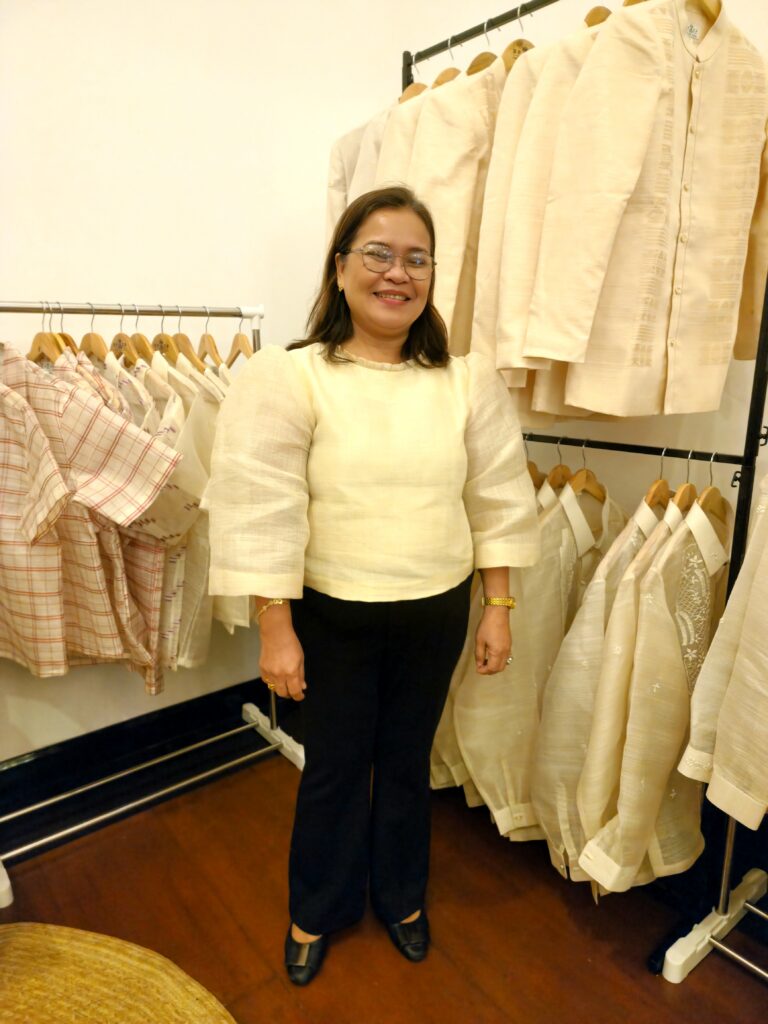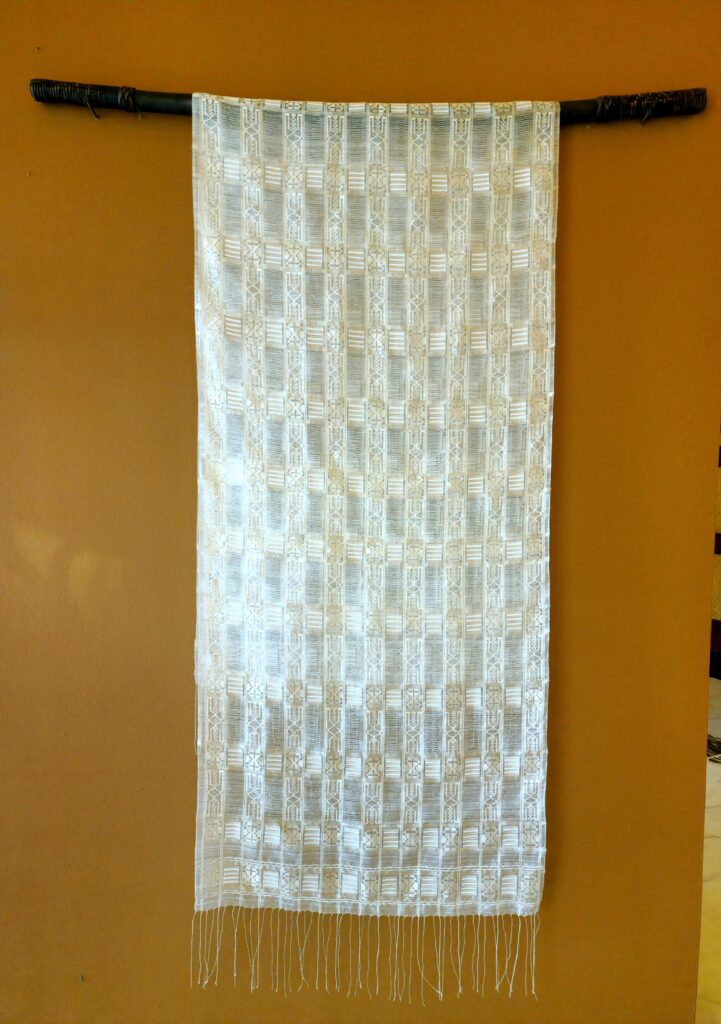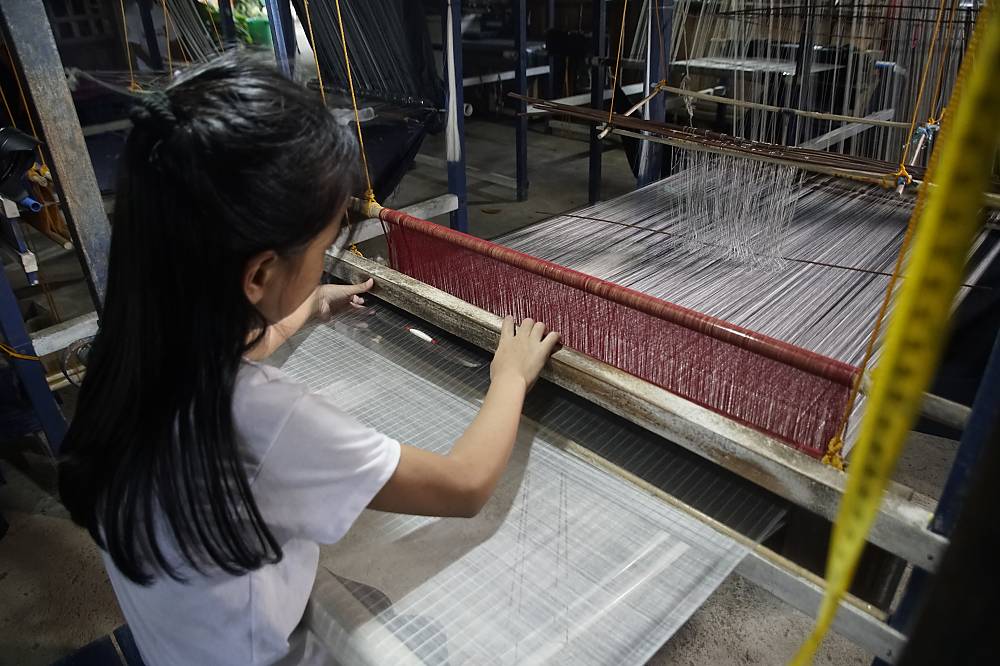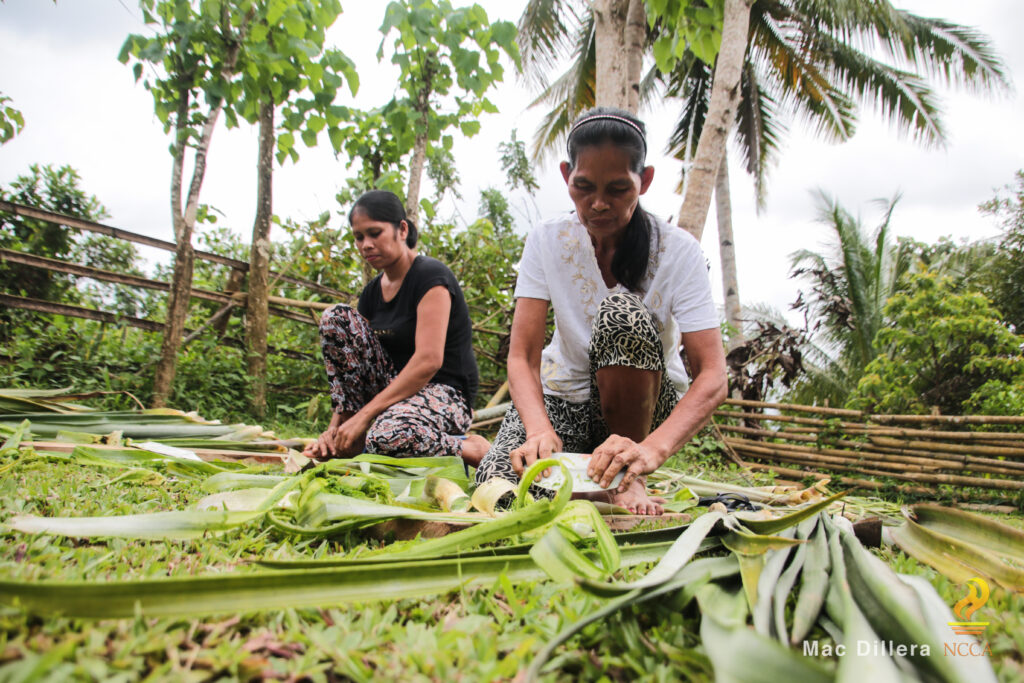The pineapple textile, locally called piña, is among the most recognizable handwoven fabrics in the Philippines. It distinguishes itself with the use of the fiber of the pineapple leaves, as most traditional Philippine handwoven textiles use cotton and abaca; and its characteristics—a translucent fabric with an elegant luster and the color of ivory, remarkable for its delicacy and simplicity.
Highly prized because of its beauty and the tedious process to make it, the piña is used as prime material in formal attires such as the terno and the barong Tagalog, as well as in finery and other objects, often embroidered or painted on, becoming a vessel for another creative expression. Piña products are often passed on as heirloom pieces.




The craft and tradition of the handwoven piña or pineapple textile of the province of Aklan was inscribed on the Representative List of the Intangible Cultural Heritage of Humanity on 5 December (6 December in the Philippines) by the United Nations Educational, Scientific and Cultural Organization or UNESCO because of its importance in demonstrating the diversity of cultures and creative expressions of the country and of the world.
The declaration was done during the 18th Session of the Intergovernmental Committee in Kasane, Botswana, held from 4 to 9 December. The gathering, held annually, was attended by representatives of states parties, non-governmental organizations, cultural institutions and other stakeholders from across the globe.
The committee, chaired by Mustaq Moorad, ambassador and Permanent Delegate of the Republic of Botswana to UNESCO, tackled the nomination of piña, made by the National Commission for Culture and the Arts or NCCA, noting that “the nomination satisfies certain criteria for inscription on the Representative List of the Intangible Cultural Heritage of Humanity,” and commending “the State Party on a well-prepared file that features broad involvement of the communities, groups and individuals concerned and a well-thought-out safeguarding plan.”
An outcome of the 2003 Convention for the Safeguarding of the Intangible Cultural Heritage, the UNESCO maintains two intangible cultural heritage or ICH lists: The Representative List of the Intangible Cultural Heritage of Humanity, which comprises “elements that help demonstrate the diversity of this heritage and raise awareness about its importance;” and the List of Intangible Cultural Heritage in Need of Urgent Safeguarding, which includes elements that “require urgent measures to keep them alive.”
UNESCO also maintains the Register of Good Safeguarding Practices, which “allows States Parties, communities and other stakeholders to share successful safeguarding experiences and examples of how they surmounted challenges faced in the transmission of their living heritage, its practice and knowledge to the future generation.”
UNESCO is more known for keeping the World Heritage List for tangible cultural and natural heritage such as monuments, settlements, buildings, geological formations and many others. It started a similar compendium for ICH in 2008.
After the session in Botswana, the UNESCO committee has inscribed 45 elements on the Representative List of the Intangible Cultural Heritage of Humanity and six elements on the List of Intangible Cultural Heritage in Need of Urgent Safeguarding. It has also selected four programs for the Register of Good Safeguarding Practices. The committee also granted one International Assistance request.
The Intangible Cultural Heritage lists now feature 694 elements from 140 countries. On the other hand, the Register of Good Safeguarding Practices now features 37 practices from 31 countries.
Aklan piña handloom weaving is the fifth intangible cultural heritage element from the Philippines to be inscribed, after the hudhud chants and the punnuk ritual of the Ifugao, the Darangen epic of the Meranaw and the buklog ritual of the Subanen, which was inscribed in the separate List of Intangible Cultural Heritage in Need of Urgent Safeguarding.
On the other hand, NCCA’s flagship program of transmitting traditional knowledge and skill, the School of Living Traditions was inscribed in the Register of Good Safeguarding Practices.





Expressions of pride and gratitude
“It is my singular honor to present to you the barong Tagalog, made of piña, a gift from the Akeanon community of the Philippines who made the cloth and who practices an age-old weaving tradition,” responded Ivan Henares, head of the NCCA Subcommission on Cultural Heritage and secretary general of the UNESCO National Commission of the Philippines, who attended the session upon the inscription of the piña.
“Today, we are honored to witness this tradition join the long list of traditions from all over the world in the Representative List of the Intangible Cultural Heritage,” he added.
The Philippines presented a short video containing messages from Junever Mahilum-West, Permanent Delegate of the Philippines to UNESCO; and NCCA chairman Victorino Mapa Manalo; and expressions of gratitude from the piña weavers, workers and supporters in Aklan.
“The Philippines is the only country that extensively produces piña cloth in the whole world,” Manalo said. “The pineapple textile or piña of Aklan is part of the diverse traditional textile weaving practices of the Philippines. This stands out as a national cultural icon, symbolizing ingenuity, patient ‘craftspersonship’ and social cohesiveness, as well as the shared values of our communities.”
During a press conference on 11 December, Aklan governor Jose Enrique Miraflores noted that the ICH inscription is a first for the Visayas region and mentioned that there have been safeguarding measures undertaken in the province before the inscription.
“This UNESCO inscription also inspires us more to uphold this tradition and safeguard it, not only for our community and the country and now in larger context as part of the tapestry of creativity of the world,” he added.
On the other hand, Theresa P. Lazaro, former Permanent Delegate to UNESCO and currently Undersecretary for Bilateral Relations and ASEAN Affairs of the Department of Foreign Affairs, related that the nomination of the piña started in 2018 together with the nomination of the buklog, and characterized it as tedious.
“I wish…to acknowledge the invaluable contribution of the NCCA team behind the nomination — Cultural Communities and Traditional Arts Section, headed by Renee Talavera. Congratulations also to the documentation team, who have been crucial in shaping a successful and expertly written nomination dossier — Nestor Horfilla and Roel Hoang Manipon,” she said. “These teams have been working on the ground, gathering data and materials, working with the communities, writing and editing the dossier, making the video, and many other details that the nomination entails.
“And most importantly, I would like acknowledge the weavers and workers of the piña industry in Aklan, who despite the odds have keep this tradition alive, sustaining this exquisite craftsmanship, for all of us, for the whole country to be proud of and now for the whole world to treasure. We salute all of you.”
“These weavers, knotters, scrapers, farmers and embroiderers are our culture-bearers. They inspire us to safeguard our heritage as they have remained faithful to their culture, have not turned their backs on their roots, and have fully embraced their tradition, which is an intangible wealth they possess,” affirmed Senate President Pro Tempore Loren Legarda, who has been supportive of NCCA programs and in promoting indigenous cultures.
“We hope that [the inscription] brings awareness not just on the safeguarding and recognition of the piña handloom weaving, but will also give importance to other significant cultural treasures that our country possesses,” she added.
A cultural master’s tale
Piña weaver and entrepreneur Raquel Eliserio, who is regarded as a cultural master on the craft from the town of Balete, related her story as a practitioner, becoming emotional.
“Weaving is a legacy I received from my ancestors. I grew up with it. I saw how important it is for my grandparents and parents. Every day, this was what they do. We did not worry where to get their daily needs because they have pineapples planted. This was their livelihood. I embraced and continued this tradition and culture, which was passed down from my ancestors,” she shared in Filipino.
Eliserio related how she strived to be a skillful weaver and diligently taught the craft to others in her community.
“Now, my family has grown bigger, a family of weavers. I consider them my family because they have shared their lives with me and piña is my way to help them,” she said.
She further said that she spent most of her life centered on piña weaving, and has gained recognition by winning several contests. She has wondered where this dedication to the craft would lead, and she believes that the UNESCO inscription is an answer.
Journey of the piña
The weaving of the piña is estimated to be about two centuries old, starting after the introduction of the pineapple to the Philippines, and the process remains almost unchanged through time.
The Akeanon people of the province of Aklan in the northwestern portion of Panay Island, part of the Visayan cluster of islands in central Philippines, are known for producing the piña. Production is historically concentrated in the barangays of Old Buswang and New Buswang in the capital town of the province, Kalibo, as well as in nearby municipalities, such as Makato, Tangalan, Balete, Banga and Lezo. Recently, practice of the craft spread in other areas such the provinces of Antique, Capiz, Leyte, Camarines Sur and Palawan.
Until today, piña weaving is alive in Aklan, considered as a family and community heritage, and the knowledge and skill are passed on in traditional ways. Recently, different organizations, both governmental and non-governmental, provide assistance in the transfer of knowledge such as the School of Living Traditions of the National Commission for Culture and the Arts.
The production of the piña starts with the cultivation of the Red Spanish pineapple cultivar, locally called pinya Bisaya, both in the backyards of houses and in larger farms. In Aklan, pineapple farms exist in 15 municipalities — Altavas, Balete, Banga, Batan, Buruanga, Kalibo, Lezo, Libacao, Madalag, Makato, Malay, Malinao, Nabas, Numancia, and Tangalan.
After 18 to 24 months, the leaves of the pineapple plants are deemed mature enough to be harvested. Fibers are then extracted from the leaves. Using a shard of porcelain, the scraper removes the epidermis of the leaf, extracting the rough fiber, called “bastos.” To extract the finer and more valued “liniwan,” a coconut shell is run across the inner layer.
The next step, the degumming, involves repeated washing of fibers in running water, usually in rivers. Fibers are then air-dried and bundled. The amount of fiber is measured by local weighing method, using old coins of different denominations and sikapat, a local unit of measurement.
The fibers are knotted to form long, continuous strands, coiled in a clay pot to prevent tangling and spooled around bamboo bobbins. Threads are then put into a sab-ongan, or warp wheel, for desired dimensions.
The fibers are then ready for weaving. The weaver usually work at home, on a wooded upright pedal loom with two or four foot-operated bamboo treadles in a space in the house designated for weaving.
The common patterns used are the ringgue (lace weave), pili (inlaid weave, and tablero (checkered pattern), or a combination of these.
A wide range of people and workers — farmers, scrapers, knotters, warpers, weavers and also traders and designers — are bound together by piña textile making, a livelihood passed on to younger members of the communities, nurturing a sense of belonging, mutual respect and interdependence among practitioners and bearers.
The piña, an epitome of Akeanon traditional craftsmanship and articulation of native aesthetics, has become a cultural marker for the Philippines and a living heritage esteemed by the whole world.
